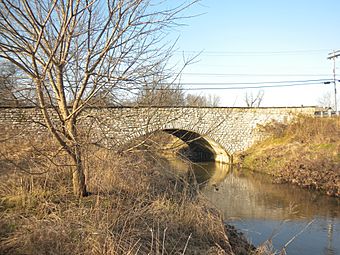County Bridge No. 148 facts for kids
Quick facts for kids |
|
|
County Bridge No. 148
|
|

County Bridge No. 148, December 2009
|
|
| Location | Pennsylvania Route 926 over Chester Creek, near Westtown, Westtown Township, Pennsylvania |
|---|---|
| Area | less than one acre |
| Built | 1911 |
| Built by | McCormick, P.J., & Sons |
| MPS | Highway Bridges Owned by the Commonwealth of Pennsylvania, Department of Transportation TR |
| NRHP reference No. | 88000879 |
| Added to NRHP | June 22, 1988 |
County Bridge No. 148 is a special old bridge located in Westtown Township, Chester County, Pennsylvania. It's a stone arch bridge that crosses a small branch of Chester Creek. This bridge is important because it's a great example of how bridges were built a long time ago.
The bridge was built in 1911, which means it's over 100 years old! It has a unique shape called a "camelback" because its top looks like a camel's hump. It's made from strong, roughly square stones.
Contents
What is County Bridge No. 148?
County Bridge No. 148 is a historic stone arch bridge. It helps people cross a part of Chester Creek. The bridge is 36 feet long, which is about the length of a school bus. It was built to last, using strong stone materials.
How Was the Bridge Built?
The bridge was constructed in 1911 by a company called McCormick, P.J., & Sons. They used a method where stones were carefully shaped and fitted together. This created a very strong arch that could support the weight of traffic. The "camelback" shape helps distribute the weight evenly.
Why is This Bridge Important?
County Bridge No. 148 is important because it shows us how engineering and construction were done in the early 20th century. It's a piece of history that is still in use today.
National Register of Historic Places
Because of its historical value, County Bridge No. 148 was added to the National Register of Historic Places in 1988. This is a special list kept by the United States government. Being on this list means a place is important to the history of the country. It helps protect these places for future generations to enjoy and learn from.



